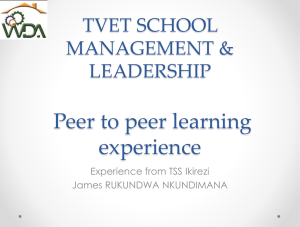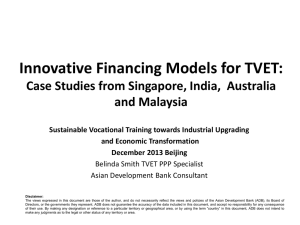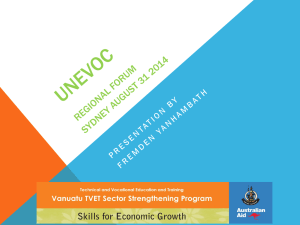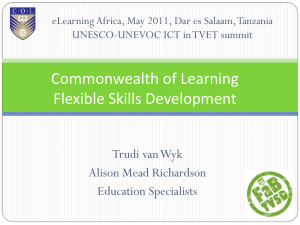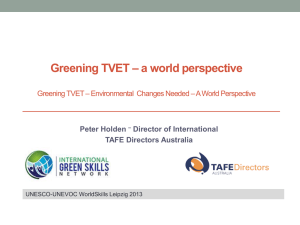Ho Young Oh
advertisement
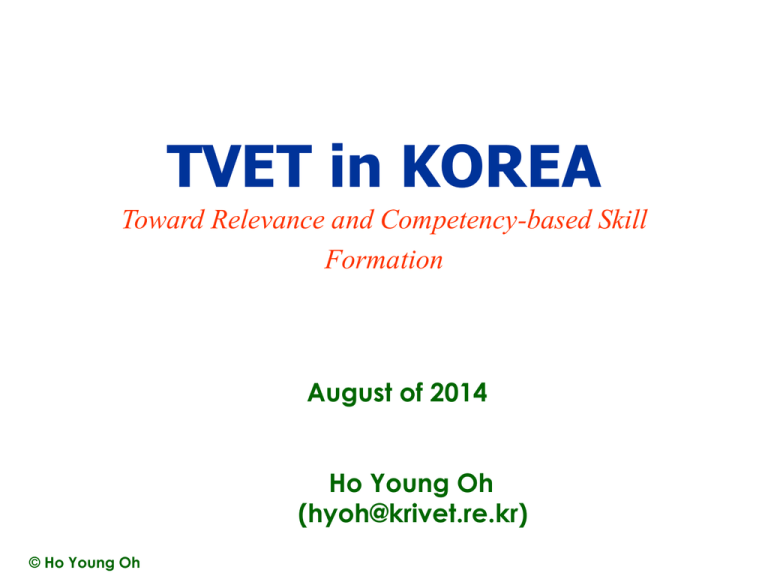
TVET in KOREA Toward Relevance and Competency-based Skill Formation August of 2014 Ho Young Oh (hyoh@krivet.re.kr) © Ho Young Oh Contents 1. Overview 2. Key Economic & Social Priorities in TVET 3. Enablers & Barriers to Investment in TVET 4. Evidence-based Research © Ho Young Oh 1. Overview Korea’s GNP Per Capita 25,000 (US$) 22,708 20,000 15,000 10,000 Semi-conductors Textiles Automobiles Mobile phones, DTV, shipbuildings, etc. 5,000 1970 1972 1974 1976 1978 1980 1982 1984 1986 1988 1990 1992 1994 1996 1998 2000 2002 2004 2006 2008 2010 2012 - 255 (Source : Bank of Korea) © Ho Young Oh 1. Overview College Enrollment Rate & Youth Employment Rate College enrollment rate(%) Youth employment rate(%) 90.0 49.0 80.0 47.0 70.0 45.0 60.0 43.0 50.0 41.0 college enrollment rate youth employment rate 40.0 39.0 © Ho Young Oh 2013 2012 2011 2010 2009 2008 2007 2006 2005 2004 2003 2002 2001 2000 1999 1998 1997 1996 1995 1994 35.0 1993 20.0 1992 37.0 1991 30.0 1. Overview Widening Discrepancy between Education & Industry Skill mismatch : Supply-driven system with emphasis on education and training institutions such as vocational education confined within the school classroom & low engagement in vocational education within industry Quantity mismatch : College enrollment rate is too high. Young people are competing to pad their resumes with qualifications that are irrelevant to their jobs. Low youth employment, longer period of school-to-work transition and skill mismatch. Companies have to pay for reeducation for newly hired graduates. © Ho Young Oh 2. Key Economic & Social Priorities for TVET 1) Enhancing Industry Relevance of TVET Development and dissemination of National Competency Standards(NCS) : NCS standardizes the knowledge, skills and attitudes required to perform a job in the workplace by industry sector and competency levels. : NCS provides a job specifications and guidelines to foster the talent needed by industry. Goal : Make irrelevant TVET relevant to industrial needs and client-oriented TVET Improve students & trainees employability; higher labour productivity & company satisfaction with TVET © Ho Young Oh 2. Key Economic & Social Priorities for TVET 1) Enhancing Industry Relevance of TVET Complete the development of NCS for all job areas by 2014. : Apply NCS to vocational high school curricula (pilot operation in three schools). The new curriculum model will be spread to other schools. : NCS will be reflected in vocational training courses by 2015. : Qualification system will be reformed in line with NCS : Help companies’ personnel management systems transform into NCS-based ones that are suitable for individual companies © Ho Young Oh 2. Key Economic & Social Priorities for TVET 2) Introducing the Work-Study Dual System Demand Driven VET System = Work-Study Dual System : Companies are responsible for teaching their new recruits necessary job skills. : Schools and training institutions complement these skills with theoretical education. Companies are invited to apply for participation in the system; successful applicants are supplied with necessary OJT programs and instructors. The government is trying to institutionalize measures to evaluate, and provide qualifications to those who have completed training. © Ho Young Oh 2. Key Economic & Social Priorities for TVET 2) Introducing the Work-Study Dual System Individual benefits : Young job seekers are employed early without having to acquire unnecessary qualifications, which saves considerable time and cost in school-to-work transition. : Companies are able to encourage longer service and save large sums of money spent for retraining new employees. © Ho Young Oh 2. Key economic & social priorities for TVET 3) Region and Industry-led TVET Change the key TVET actor by transforming the centralized, supply-driven TVET into a region- and industry-led one. Region- and Industry-led HRD was introduced in 2013, and industrial circles, such as workers’ and employers’ organizations, local government, regional employment and labour office, office of education, etc., set up local HRD councils jointly in 14 local areas. : Conducted training-demand surveys for employers and job seekers. : Selected 27 joint education and training institutions to provide training to 38,000 people. © Ho Young Oh 3. Enablers and Barriers to Investment in TVET Enablers Employment Insurance (EI) System Barriers Entry Barriers into TVET Manufacturing-centered TVET Unstable industrial relation Low recognition for TVET Wage differentials between large & SMEs, labor mobility Meister high school Job crisis among youth Retirement of baby boomers Rapidly changing industry © Ho Young Oh 4. Evidence-based Research National think tanks under prime minister’s office : KRIVET(Korea Research Institute for Vocational Education & Training), KLI(Korea Labour Institute), KDI(Korea Development Institute), etc. Surveys : Graduates Occupational Mobility Survey : Training Demand Survey : Economically Active Population Survey Disclosure of Information : Information service of “Higher Education in KOREA” © Ho Young Oh Thank you!! © Ho Young Oh

